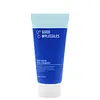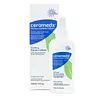What's inside
What's inside
 Key Ingredients
Key Ingredients

 Benefits
Benefits

 Concerns
Concerns

 Ingredients Side-by-side
Ingredients Side-by-side

Water
Skin ConditioningCaprylic/Capric Triglyceride
MaskingCaprylic/Capric/Succinic Triglyceride
EmollientGlycerin
HumectantVitis Vinifera Seed Oil
EmollientCetearyl Alcohol
EmollientSucrose Cocoate
EmulsifyingPolycitronellol
Behenyl Alcohol
EmollientPrunus Domestica Seed Extract
EmollientDimer Dilinoleyl Dimer Dilinoleate
EmollientC28-52 Olefin/Undecylenic Acid Copolymer
Propanediol
SolventBehenyl Behenate
EmollientTamarindus Indica Seed Gum
Emulsion StabilisingBetulin
Skin ConditioningPotassium Cetyl Phosphate
EmulsifyingPentylene Glycol
Skin ConditioningCaprylyl Glyceryl Ether
CleansingOryzanol
Skin ConditioningXanthan Gum
EmulsifyingPolyhydroxystearic Acid
EmulsifyingEuphorbia Cerifera Wax
Hydroxyacetophenone
AntioxidantPhospholipids
Skin ConditioningCaprylhydroxamic Acid
Trisodium Ethylenediamine Disuccinate
Citric Acid
BufferingCeramide NP
Skin ConditioningSodium Stearoyl Glutamate
CleansingPhytosterols
Skin ConditioningTocopherol
AntioxidantLecithin
EmollientCeramide AP
Skin ConditioningHelianthus Annuus Seed Oil
EmollientSphingolipids
EmollientSodium Citrate
BufferingAscorbyl Palmitate
AntioxidantOleic Acid
EmollientGlyceryl Caprylate
EmollientMyristic Acid
CleansingPalmitic Acid
EmollientCaprylyl Glycol
EmollientP-Anisic Acid
MaskingWater, Caprylic/Capric Triglyceride, Caprylic/Capric/Succinic Triglyceride, Glycerin, Vitis Vinifera Seed Oil, Cetearyl Alcohol, Sucrose Cocoate, Polycitronellol, Behenyl Alcohol, Prunus Domestica Seed Extract, Dimer Dilinoleyl Dimer Dilinoleate, C28-52 Olefin/Undecylenic Acid Copolymer, Propanediol, Behenyl Behenate, Tamarindus Indica Seed Gum, Betulin, Potassium Cetyl Phosphate, Pentylene Glycol, Caprylyl Glyceryl Ether, Oryzanol, Xanthan Gum, Polyhydroxystearic Acid, Euphorbia Cerifera Wax, Hydroxyacetophenone, Phospholipids, Caprylhydroxamic Acid, Trisodium Ethylenediamine Disuccinate, Citric Acid, Ceramide NP, Sodium Stearoyl Glutamate, Phytosterols, Tocopherol, Lecithin, Ceramide AP, Helianthus Annuus Seed Oil, Sphingolipids, Sodium Citrate, Ascorbyl Palmitate, Oleic Acid, Glyceryl Caprylate, Myristic Acid, Palmitic Acid, Caprylyl Glycol, P-Anisic Acid
Water
Skin ConditioningCaprylic/Capric Triglyceride
MaskingGlycerin
HumectantCetearyl Alcohol
EmollientGlyceryl Stearate Se
EmulsifyingCeramide NP
Skin ConditioningLecithin
EmollientAlpha-Glucan Oligosaccharide
CleansingOphiopogon Japonicus Root Extract
Skin ConditioningCoco-Caprylate/Caprate
EmollientButyrospermum Parkii Butter
Skin ConditioningGlyceryl Linoleate
EmollientGlyceryl Linolenate
EmollientDimethicone
EmollientTocopherol
AntioxidantGlyceryl Oleate
EmollientPotassium Cetyl Phosphate
EmulsifyingPanthenol
Skin ConditioningAllantoin
Skin ConditioningAlgae Extract
EmollientAloe Barbadensis Leaf Juice
Skin ConditioningUlva Lactuca Extract
Skin ConditioningYeast Extract
Skin ConditioningAscorbic Acid
AntioxidantHydrolyzed Soy Protein
HumectantRosa Canina Fruit Oil
EmollientXanthan Gum
EmulsifyingMaltodextrin
AbsorbentMethylpropanediol
SolventDidecyldimonium Chloride
EmulsifyingSorbitol
HumectantPolyquaternium-80
CleansingCaprylyl Glycol
EmollientWater, Caprylic/Capric Triglyceride, Glycerin, Cetearyl Alcohol, Glyceryl Stearate Se, Ceramide NP, Lecithin, Alpha-Glucan Oligosaccharide, Ophiopogon Japonicus Root Extract, Coco-Caprylate/Caprate, Butyrospermum Parkii Butter, Glyceryl Linoleate, Glyceryl Linolenate, Dimethicone, Tocopherol, Glyceryl Oleate, Potassium Cetyl Phosphate, Panthenol, Allantoin, Algae Extract, Aloe Barbadensis Leaf Juice, Ulva Lactuca Extract, Yeast Extract, Ascorbic Acid, Hydrolyzed Soy Protein, Rosa Canina Fruit Oil, Xanthan Gum, Maltodextrin, Methylpropanediol, Didecyldimonium Chloride, Sorbitol, Polyquaternium-80, Caprylyl Glycol
 Reviews
Reviews

Ingredients Explained
These ingredients are found in both products.
Ingredients higher up in an ingredient list are typically present in a larger amount.
This ingredient is an emollient, solvent, and texture enhancer. It is considered a skin-softener by helping the skin prevent moisture loss.
It helps thicken a product's formula and makes it easier to spread by dissolving clumping compounds.
Caprylic Triglyceride is made by combining glycerin with coconut oil, forming a clear liquid.
While there is an assumption Caprylic Triglyceride can clog pores due to it being derived from coconut oil, there is no research supporting this.
Learn more about Caprylic/Capric TriglycerideCaprylyl Glycol is a humectant and emollient, meaning it attracts and preserves moisture.
It is a common ingredient in many products, especially those designed to hydrate skin. The primary benefits are retaining moisture, skin softening, and promoting a healthy skin barrier.
Though Caprylyl Glycol is an alcohol derived from fatty acids, it is not the kind that can dry out skin.
This ingredient is also used as a preservative to extend the life of products. It has slight antimicrobial properties.
Learn more about Caprylyl GlycolCeramide NP is a type of ceramide and formally known as ceramide 3.
Ceramides are intercellular lipids naturally found in our skin that bonds dead skin cells together to create a barrier. They are known for their ability to hold water and thus are a great ingredient for dry skin.
Ceramides are an important building block for our skin barrier. A stronger barrier helps the skin look more firm and hydrated. By bolstering the skin ceramides act as a barrier against irritating ingredients. This can help with inflammation as well.
If you would like to eat ceramides, sweet potatoes contain a small amount.
Read more about other common types of ceramides here:
Ceramide AP
Ceramide EOP
Cetearyl alcohol is a mixture of two fatty alcohols: cetyl alcohol and stearyl alcohol. It is mainly used as an emulsifier. Emulsifiers help prevent the separation of oils and products. Due to its composition, it can also be used to thicken a product or help create foam.
Cetearyl alcohol is an emollient. Emollients help soothe and hydrate the skin by trapping moisture.
Studies show Cetearyl alcohol is non-toxic and non-irritating. The FDA allows products labeled "alcohol-free" to have fatty alcohols.
This ingredient is usually derived from plant oils such as palm, vegetable, or coconut oils. There is debate on whether this ingredient will cause acne.
Due to the fatty acid base, this ingredient may not be Malassezia folliculitis safe.
Learn more about Cetearyl AlcoholGlycerin is already naturally found in your skin. It helps moisturize and protect your skin.
A study from 2016 found glycerin to be more effective as a humectant than AHAs and hyaluronic acid.
As a humectant, it helps the skin stay hydrated by pulling moisture to your skin. The low molecular weight of glycerin allows it to pull moisture into the deeper layers of your skin.
Hydrated skin improves your skin barrier; Your skin barrier helps protect against irritants and bacteria.
Glycerin has also been found to have antimicrobial and antiviral properties. Due to these properties, glycerin is often used in wound and burn treatments.
In cosmetics, glycerin is usually derived from plants such as soybean or palm. However, it can also be sourced from animals, such as tallow or animal fat.
This ingredient is organic, colorless, odorless, and non-toxic.
Glycerin is the name for this ingredient in American English. British English uses Glycerol/Glycerine.
Learn more about GlycerinLecithin is a term for a group of substances found in the cell membranes of plants, animals, and humans. They are made up of mixture of phospholipids.
This ingredient has emollient and emulsifying properties.
As an emollient, lecithen helps soften the skin and creates a barrier to keep moisture in.
As an emulsifier, it also helps prevent water and oil ingredients from separating. Lecithin can also help ingredients be better absorbed by the skin.
This is because the phospholipids in lecithin produce liposomes. Liposomes help other ingredients get through the skin barrier.
Depending on the source of this ingredient, lecithin may not be fungal acne safe. This is because some sources of lecithin come from soybean oil, which may feed the malassezia yeast that feeds fungal acne.
We recommend reaching out to the brand you are purchasing from to inquire about the source of their lecithin.
Some other names for this ingredient include soy lecithin and deoiled soy lecithin.
Learn more about LecithinPotassium Cetyl Phosphate is the potassium salt of a mixture. This mixture consists of the esters from phosphoricacid and cetyl alcohol.
Potassium Cetyl Phosphate is an emulsifier and cleansing agent. Emulsifiers help stabilize a product. It does this by preventing certain ingredients from separating.
As a cleansing agent, Potassium Cetyl Phosphate helps gather oils, dirts, and pollutants from your skin. This makes it easier to rinse them away with water.
Learn more about Potassium Cetyl PhosphateTocopherol (also known as Vitamin E) is a common antioxidant used to help protect the skin from free-radicals and strengthen the skin barrier. It's also fat soluble - this means our skin is great at absorbing it.
Vitamin E also helps keep your natural skin lipids healthy. Your lipid skin barrier naturally consists of lipids, ceramides, and fatty acids. Vitamin E offers extra protection for your skin’s lipid barrier, keeping your skin healthy and nourished.
Another benefit is a bit of UV protection. Vitamin E helps reduce the damage caused by UVB rays. (It should not replace your sunscreen). Combining it with Vitamin C can decrease sunburned cells and hyperpigmentation after UV exposure.
You might have noticed Vitamin E + C often paired together. This is because it is great at stabilizing Vitamin C. Using the two together helps increase the effectiveness of both ingredients.
There are often claims that Vitamin E can reduce/prevent scarring, but these claims haven't been confirmed by scientific research.
Learn more about TocopherolWater. It's the most common cosmetic ingredient of all. You'll usually see it at the top of ingredient lists, meaning that it makes up the largest part of the product.
So why is it so popular? Water most often acts as a solvent - this means that it helps dissolve other ingredients into the formulation.
You'll also recognize water as that liquid we all need to stay alive. If you see this, drink a glass of water. Stay hydrated!
Learn more about WaterXanthan gum is used as a stabilizer and thickener within cosmetic products. It helps give products a sticky, thick feeling - preventing them from being too runny.
On the technical side of things, xanthan gum is a polysaccharide - a combination consisting of multiple sugar molecules bonded together.
Xanthan gum is a pretty common and great ingredient. It is a natural, non-toxic, non-irritating ingredient that is also commonly used in food products.
Learn more about Xanthan Gum